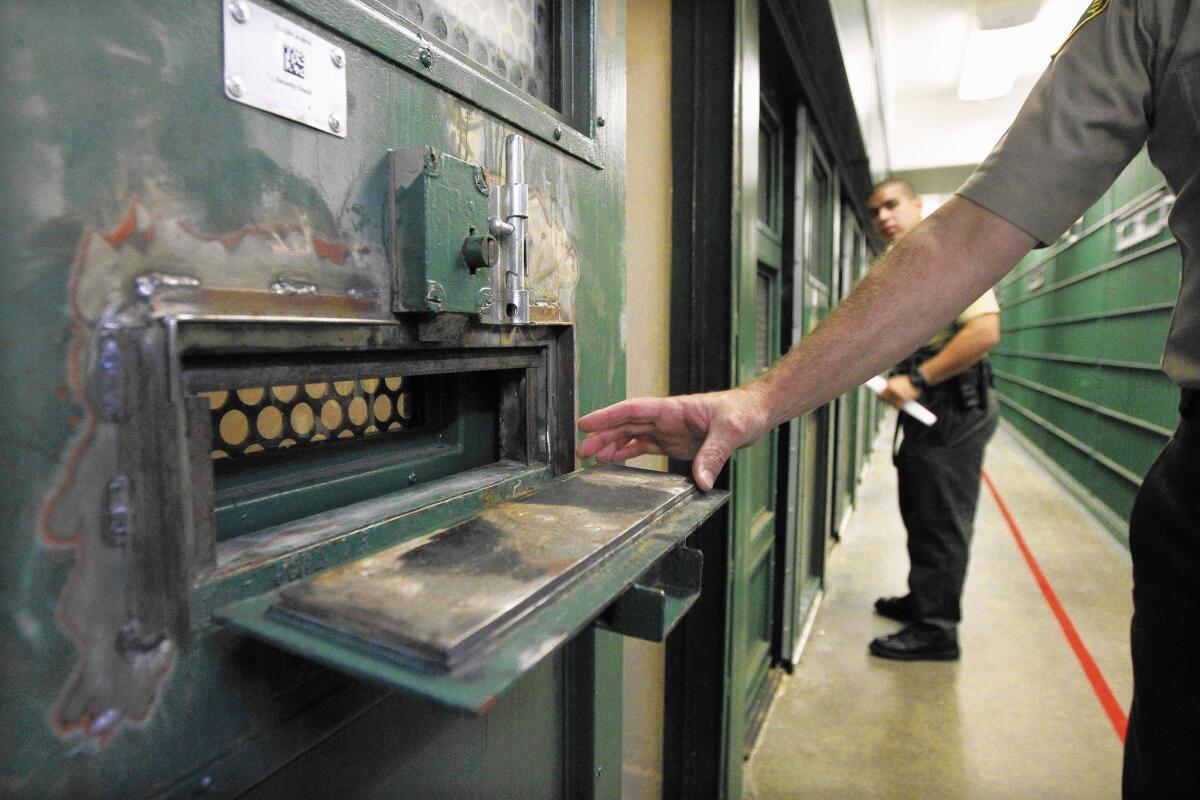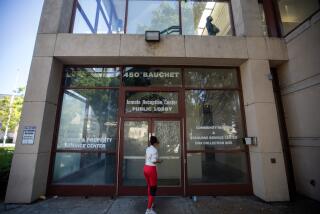Jail cracks down on inmates’ pungent assaults on deputies

The foul-smelling glob splattered into Deputy Stephen Vasquez’s mouth and eyes.
The inmate who was suspected of throwing it said the mixture was only water and apple jelly, according to an incident report. But Vasquez thought he tasted urine, and a witness told investigators that the suspect had bragged about making a “thick mix” using human waste.
It was Vasquez’s first day patrolling a cellblock at the Men’s Central Jail. Rather than shower right away, Vasquez had to pose for photographs that could be used as evidence. For a week, until the blood tests came back negative, he slept on the couch, apart from his fiancee.
“It was very unpleasant,” he said.
The March 5 incident was part of a recent fivefold increase in gassings — throwing bodily substances, typically urine or feces — at the downtown Men’s Central Jail.
Inmates sometimes mix the waste with fruit jelly so there’s a better chance that it will stick to their target. Tapatio hot sauce packs a sting. Milk cartons are used as containers, and sometimes as launchers to force the substance out through a narrow crack. Other techniques produce a spray that rains down like an unwelcome shower, jail officials said.
Sometimes, gassers team up or compete with one another.
“Most do it because they want attention or they’re bored or they have some other issue with respect to their mental state,” said Custody Operations Chief Eric Parra, who oversees the Men’s Central Jail and several other county lockups.
In the first four months of 2014, there were 25 gassing attacks against Men’s Central Jail employees, compared with five in the same period the previous year — mostly on the notorious 3000 floor, where some of Los Angeles County’s most dangerous inmates are housed.
There were nine gassings in April, including a chaotic scene in which an entire row of inmates hurled noxious missiles at guards.
Some officials in the Sheriff’s Department attribute the increased attacks to a change in the climate at the Men’s Central Jail, which houses about 4,800 inmates.
After a blue-ribbon commission issued a scathing report in 2012 and brutality charges were filed against seven sheriff’s officials, they said, deputies began to use less physical force and inmates started testing the new boundaries.
“Things got lax for a while,” said Sheriff’s Capt. Daniel Dyer, who runs the jail, “and the inmates sensed that.”
Jeffrey Steck, president of the Assn. for Los Angeles Deputy Sheriffs, said the department overreacted to the violence issues. The result, according to Steck, was an “unwillingness to use the level of force required by the situation” — and an increase in gassings.
“These guys were not doing it for anger or mental illness. They were just doing this because they could,” Steck said of the gassers. “It was fun to do because they were bored. They could do this and there would be no ramifications.”
Gassing is a hazard of the job, but one that Steck and others in the union felt had reached unacceptable levels.
Jail officials have recently taken measures — including fortifying cells, purchasing hazmat suits and denying television privileges to gassers — that Steck said seem to be helping.
Under current law, gassers can receive two to four years in state prison, but they can also get off with a misdemeanor. The union is joining with department officials to call for an increase in the criminal penalty.
“If word gets out that you will be sentenced to [at least] a year, it will help,” Dyer said.
The worst gassers are segregated in a row of cells where there are no televisions. Their meals consist of the “jute ball” or “loaf” — a block of tasteless nutrients provided in lieu of regular food.
For a time, inmates and jail officials on “gassers’ alley” engaged in a game of one-upmanship. After cell doors were reinforced with metal strips on the edges, the prisoners pushed waste-filled cocktails through other cracks.
The greatest vulnerability was the flap that is lowered to slide in a food tray at mealtimes. Jail handymen have rigged the openings with padlocks and extra panels as they await an emergency shipment of gassing-proof meal slots.
The new measures seem to have brought a temporary truce.
Since the April spate, there have only been three gassings, according to jail statistics. Three of the original group of nine or so remain in gassers’ alley after the rest earned their way back into the general population.
So far, the former gassers have not re-offended, officials said.
Supervisors at the Men’s Central Jail are trying to improve the situation by using rewards as well as punishment, making an effort to hear out inmates’ grievances. Parra said he was working with the Department of Mental Health to bring counselors or religious advisors to high-security inmates who are not typically eligible for educational programs.
Patrisse Cullors, founder of the Coalition to End Sheriff Violence in L.A. Jails, said officials should examine the root causes of the gassing epidemic to see whether inmates’ needs are being met and whether particular guards are provoking the attacks.
“I’m of the belief that creating a more punitive environment just creates more violence,” Cullors said. “You might be able to squelch the gassing in the interim, but what is the long-term solution?”
Gabriel Wilcox, 37, the inmate who is charged with gassing Vasquez, was recently sentenced to more than two years on a burglary charge. He faces up to four additional years in the gassing case, which is being prosecuted as a felony. A lab test detected urine in the substance he is charged with throwing, a sheriff’s official said.
Mahin Salehi, Wilcox’s public defender, declined to comment.
“To us, it’s one of the most serious crimes in our jail, because it potentially affects the health of our employees,” Parra said. “Our goal is zero.”
More to Read
Sign up for Essential California
The most important California stories and recommendations in your inbox every morning.
You may occasionally receive promotional content from the Los Angeles Times.











